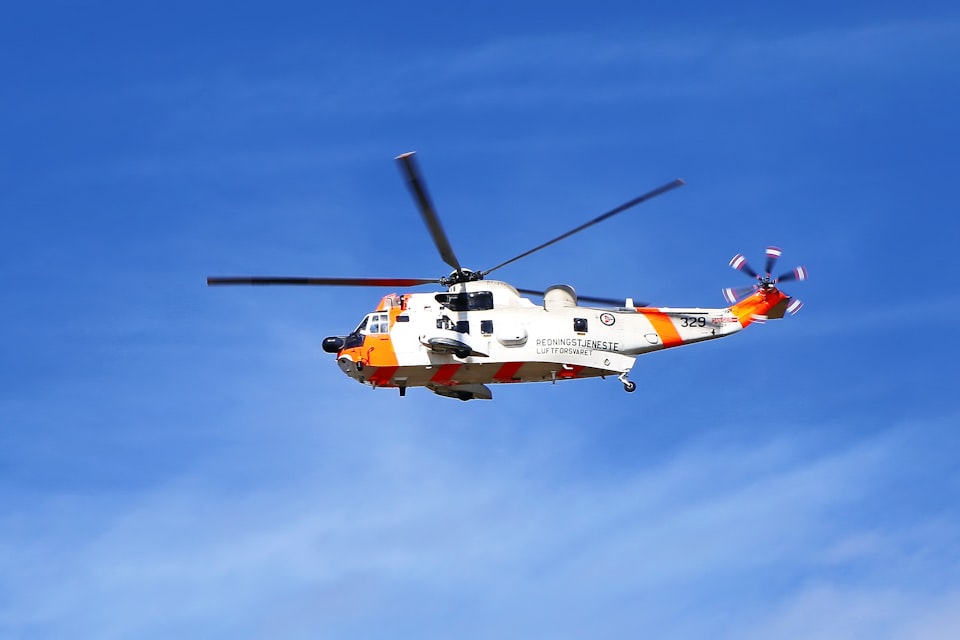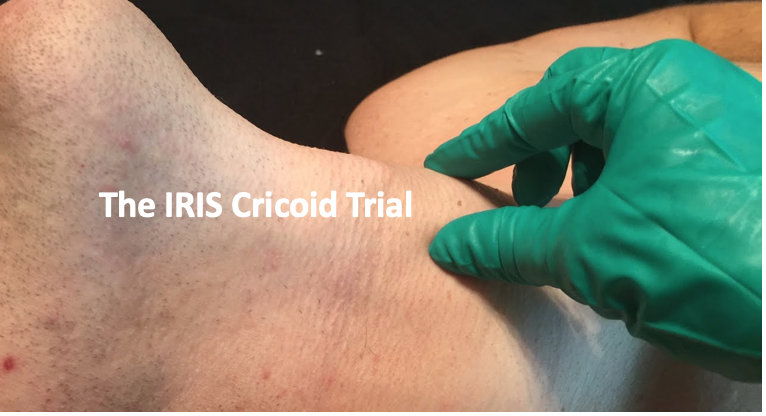RSI - what is it and why do we use it?

If you're buying stocks it's relative strength index, if you work in occupational health it's repetitive strain injury, and if you're an anaesthetist, it's Rapid Sequence Induction - (capitalised because it's terribly important).
Podcast episode
What is it?
When you anaesthetise someone in order to intubate them, generally speaking the following steps need to happen:
- Set up, monitoring, optimal positioning, IV access, preoxygenation of the patient
- Induction of general anaesthesia using a hypnotic agent
- Muscle relaxation to prevent vocal cord spasm and to allow an endotracheal tube to pass into the trachea
- Intubation
- Securing of tube and maintenance of anaesthesia
This is all well and good in a nice, gentle elective case where the patient is haemodynamically stable, fasted and at very low risk of aspirating on the contents of their empty stomach. However in an emergency or critical care scenario, with an unfasted patient with or without bowel obstruction, facial bleeding, vomiting etc we run into a bit of a problem.
All the time spent in steps 2, 3 and 4 is time where the patient is at risk of aspirating something bad into the airway, because they've received sedation and muscle relaxation and are no longer able to protect their own airway.
A spot of history

In 1946 Mendelson first described a solid contender for 'least glamorous eponymous condition' in the form of gastric aspiration syndrome.
As one might expect, the syndrome describes a chemical pneumonitis induced by aspiration of gastric content leading to hypoxia, pulmonary oedema and death.
In 1961, Sellick and Lond suggested pushing the cricoid backwards to compress the oesophagus, which we describe and complain about below.
Then in July 1970 Stept and Safar conceptualised the idea of a 15-step 'rapid induction' process to reduce the risk of aspiration in high risk patients, much of which remains in use today.
Stept and Safar's 15 nuggets of wisdom
The following fifteen bullet points are lifted directly from here, just to demonstrate how little has changed (i.e. they kinda nailed it)
- Start intravenous infusion (if not already running), preferably via plastic cannula to avoid dislodgement.
- Check equipment, including tracheal tube, cuff, stylet (for control of tube in emergency to avoid risking failure with the first attempt at intubation), adapters, oxygen source, bag-mask, and suction turned on, with a large-bore, rigid pharyngeal suction tip near the patient’s head.
- Insert a large-bore nasogastric tube and decompress the stomach with intermittent strong suction, to correct abdominal distention.
- Clean mouth and pharynx of foreign material, including dentures.
- Denitrogenate the lungs with 100 percent oxygen for at least 2 minutes, using a nonrebreathing system or a semiclosed-circle system with over 10 L/min flow and tight mask fit. Continue oxygen inhalation until intubation.
- Place patient in semisitting, V-position, with trunk elevated about 30 degrees, to counteract regurgitation by gravity, and feet elevated to prevent postural hypotension. Place pillow under occiput to support the head in the “sniffing” position for intubation.
- Apply electrocardiographic electrodes or precordial stethoscope for monitoring the heart.
- Inject d-tubocurarine (3 mg/170 kg body weight) intravenously. This may produce slight weakness, but most patients do not notice.
- Give a predetermined dose of thiopental (e.g. 150 mg/70 kg body weight) intravenously, about 2 minutes after injection of d-tubocurarine. In the stuporous or comatose patient, thiopental is omitted. In the critically ill, conscious patient, whose circulation may not tolerate thiopental, scopolamine alone is given intravenously, or cyclopropane or halothane is administered until the eyelash reflex is sluggish.
- Tilt the patient’s head gently backward with the onset of unconsciousness, and have an assistant apply and maintain firm, continuous cricoid pressure to close the oesophagus until the tracheal tube cuff is inflated at step 13.
- Inject succinylcholine chloride intravenously 100 mg/70 kg body weight, immediately after the thiopental or the onset of unconsciousness. Avoid intermittent positive pressure ventilation, as it may produce gastric insufflation and regurgitation.
- Allow respiration to cease spontaneously. Apnea is essential, since partial paralysis would result in straining and regurgitation.
- Remove the mask while sustaining cricoid pressure, expose the larynx, and intubate the trachea rapidly; then inflate the cuff. In case of vomiting prior to tracheal intubation, lower and turn the patient’s head to the side for pharyngeal suctioning.
- Release cricoid pressure; ventilate; switch to maintenance anesthetic. Position the patient and proceed with the surgical operation.
- Insert a gastric tube, if one is not already in place. This may prove difficult in the relaxed anesthetized patient.
Enter RSI
As the name suggests, rapid sequence induction simply means doing steps 2, 3 and 4 as quickly as possible, to ensure the patient spends as little time as possible in the danger zone of an unprotected airway.
Reasons to perform RSI
- To rapidly protect and maintain a patent airway
- To take control of respiratory drive in respiratory failure
- To facilitate bronchoscopy and lavage of respiratory tree
- To reduce the oxygen consumption by respiratory muscles
- To facilitate safe transfer to a tertiary centre or intensive care unit
- To facilitate other invasive interventions
- To protect a combative patient's C spine where injury suspected
- For compassionate reasons (pain mostly)
What are the risks?
- Hostile or unfamiliar environment
- Distance from help
- Team not used to intubating
- Clinically unwell patient more likely to desaturate rapidly
Only a little bit needs to be fast
It is spectacularly rare to come across a patient that needs intubating in the next five seconds.
The vast majority of the time you have at least a few minutes to optimise the patient's physiology, position and preoxygenation to maximise your chances of a successful tube.
Things to do before injecting anything
- Resuscitate your patient as much as possible*
- Grab a checklist and make a plan
- Prepare your team, equipment, environment and medications
- Decide if you need to protect the C-spine or not
- Preoxygenation
*The concept of 'crashing on induction' is banded around in reference to patients whose cardiorespiratory physiology simply can't handle the added stress of induction of anaesthesia. Yes it does happen but the reality is that a lot of the time this can be avoided with adequate resuscitation before going anywhere near the airway.
Think about:
- Fluids
- Pressors
- Atropine
- Alternative agents such as ketamine or big doses of midazolam and fentanyl
What equipment should you have ready?
- Suction
- Oxygen and lots of it*
- Mapelson C circuit or bag valve mask
- NIBP, Pulse oximetry, ECG
- End Tidal CO2 monitoring
- Endotracheal tube
- Bougie or stylet
- Igel/LMA
- Front of neck access kit
*Whacking on some nasal cannulae and firing oxygen into the nasopharynx during intubation might provide a bit of extra apnoeic oxygenation and is unlikely to do any harm
Check the cannula
Reliable IV access, preferably with a spare, is a must before attempting to intubate, for obvious reasons.
There are few scenarios as stressful as a half-anaesthetised patient with a bicep full of muscle relaxant who no longer has IV access.
Direct or video scope?
Ah the twitter argument of the decade - the answer is probably 'use what you're best at using, assuming it's available'.
- Evidence suggests that video laryngoscopy results in a higher first pass success rate
- Experience suggests that video laryngoscopy results in a higher 'oh god there's blood on the camera' rate in the emergency department
Practice with both, figure out what you're most useful with, and use that.
Assess the Airway
This sounds obvious given it is literally our day job, but in the heat of the moment with an unwell patient - particularly one who is vomiting or has a mouth full of blood - it's not uncommon to dedicate less time than one should to getting a real idea of just how tricky it's likely to be to find the cords and secure the airway.
What is the MACOCHA score?
- Mallampati class 3 or 4 = 5 points
- Apnoea (OSA) = 2 points
- C-spine stiffness = 1 point
- Opening of mouth less than 3cm = 1 point
- Coma = 1 point
- Hypoxaemia = 1 point
- Anyone other than an anaesthetist intubating = 1 point
More than 2 points suggests you're likely to face some sort of difficulty
Remember that awake fibreoptic intubation is often very feasible even in really rather sick patients, and can prevent them from getting a lot sicker very quickly.
Preoxygenation is paramount
Before plunging the syringe and diving scope-first into the pharynx, you need to rack up a bit of oxygen credit, to buy yourself as much faff time as possible, especially in patients with sick lungs.
It's all very well performing an RSI and following all the steps as prescribed, but what happens when the most crucial step:- "Put the tube between the cords" - doesn't go to plan?
You're going to need to adapt, improvise and overcome to ensure the patient's brain doesn't become dangerously hypoxic, and you want as much time at your disposal as possible.
Aim for an expired oxygen concentration of >85% if possible for optimal preoxygenation
Choose your poison
You need an induction agent and a muscle relaxant, and usually we throw in a rapid-acting opioid for good measure.
Induction agents
- Propofol 1.5-2 mg/kg (use total body weight)
- Ketamine 2 mg/kg (use ideal body weight)
- Thiopentone 5 mg/kg (use total body weight)
Muscle relaxants
- Suxamethonium 2 mg/kg (total body weight)
- Rocuronium 1 mg/kg (ideal body weight)
Don't stress about body weight calculations in an emergency - it's better to give slightly too much muscle relaxant than not enough.
Opioids
- Fentanyl 2 mcg/kg (total body weight)
- Alfentanil 40 mcg/kg (total body weight)
Fentanyl will take 90s or so to work, alfentanil will take 30s.
Technically speaking, a purebred RSI is thiopentone followed by suxamethonium because it's classically been the fastest and most reliable way get someone asleep and relaxed as quickly as possible.
However - with the advent of sugammadex making rocuronium possible to reverse essentially instantaneously, and the increasing number of anaesthetists being vastly more comfortable and experienced using propofol - the increasingly commonplace modified RSI often ends up using these two instead.
The key as always is to use the technique and medications you're most comfortable with.
The cricoid debate
It makes logical physiological sense that if you push a hard ring of cartilage against a floppy oesophagus, you can compress the oesophagus sufficiently that gastric content can't regurgitate past the pinch point.
This is what Sellick proposed in 1961.
Cricoid pressure was described in 1961, and was based upon an observational study of 26 patients. It quickly became dogma in medical practice. And here we are a half century later *still* trying to find proof of its efficacy... pic.twitter.com/GSacet9Tsm
— AirwayMan (@JohnCSakles) October 20, 2018
The advised technique is manual application of 30 N of pressure applied with 3 fingers to the cricoid cartilage.
It probably doesn't work
To begin with a Cochrane review conducted in 2015 came to the underwhelming conclusion that no randomised controlled trial data exist to either support or refute the use of cricoid pressure.
Then this large RCT from 2019 came to a rather strange triple-negative conclusion by 'failing to demonstrate non-inferiority of a sham procedure' which in simple terms means 'cricoid isn't obviously significantly different to doing a completely pointless procedure'.
(The actual data from this study found that one more patient aspirated in the cricoid group than the control group...)
If you want a succint review of this RCT, check out this fabulous bottom line review.
Even if cricoid as a technique does work, it's really hard to do correctly, and almost impossible to do properly for a sustained period of time while simultaneously trying to help someone intubate by handing them bits of equipment.
It also makes facemask ventilation and supraglottic airway device insertion more difficult.
Why not just do it anyway?
- It makes the intubation harder by distorting the neck anatomy
- Risk of oesophageal damage and rupture if patient vomits
- One handed ODP
- It's actually very hard to do properly for any sustained amount of time
- My fear - odp blaming themselves
Imagine the following scenario - you have an unfasted patient requiring emergency surgery and you opt to use cricoid during your modified RSI. Your ODP is dutifully applying cricoid pressure, and managing very well to hand you all the equipment you need while pressing on the patient's neck.
Then the patient vomits, and a slew of gastric content floods into the pharynx and mouth and down into the trachea.
The ODP didn't mess up, they were applying cricoid pressure exactly as instructed, but this happened:
😱 With some water we can see the oesophagus and it is NOT behind the trachea! Gasps in the audience.
— BucksUSGRA (@BucksUSGRA) May 4, 2023
😎 Turns out I may have been correct abandoning cricoid pressure all those years ago! #RAUK23 pic.twitter.com/UT3RnqQLPB
Often the oesophagus will simply plop to the side, and your entire manoeuvre becomes redundant.
My fear is that an ODP will perform cricoid pressure perfectly, however the patient still aspirates because cricoid doesn't really work, but the ODP then blames themselves forever for doing it wrong...
Conclusion of the #IRIS trial: “This large randomized trial failed to demonstrate the noninferiority of a sham procedure versus cricoid pressure to prevent pulmonary aspiration during rapid sequence induction of anesthesia”. https://t.co/Jypzxf9wuw
— Anesthesia&CritCare (@AnesthCritCare) October 21, 2018
Just use an NG
Any fifth year medical student worth their salt knows that if you have a patient with small bowel obstruction, then an essential part of their management is sticking an NG tube in to relieve the pressure on the bowel wall, reduce the risk of aspiration and most importantly - make the patient feel better.
Yet time and again you will find yourself briefing for a laparotomy with an unfasted patient in small bowel obstruction with no NG tube in.
Then you can merrily drain all of the gastric goop with your suction before you go anywhere near the airway, and procede to intubate safe in the knowledge the you've minimised the risk of aspiration.
Note that cricoid pressure is even more pointless if there is an NG tube in.
Do what your trust does
The harsh reality, as with many things in medicine, is that the culture of your trust often plays a significant role in how patients are treated, and many trusts in the UK still cling to cricoid pressure as if it is a golden bullet.
If your seniors are very keen on cricoid and suggest using it, it is better as a junior to go ahead and use it even if you think it's not indicated.
I say this for three reasons
- If the patient aspirates, it will be hard to justify why you changed the consultant's plan, even if the patient would have aspirated anyway
- It's unlikely to do harm (even though it theoretically can)
- As soon as you start looking for the cords, if the view isn't ideal, you can legitimately request that cricoid be removed to improve your view
External laryngeal manipulation
This is often confused for cricoid pressure - but they're very different.
ELM is designed to improve the view for intubation, by moving the larynx into the intubator's line of site.
Classically this is described as BURP - backwards, upwards and rightwards pressure, and usually the hand moving the larynx is on the thyroid cartilage.
Cricoid pressure is direct posterior pressure on the cricoid cartilage, and it's only purpose is to compress the oesophagus in order to try and reduce the risk of regurgitation of gastric content.
External Laryngeal Manipulation
— Sam Ghali, M.D. (@EM_RESUS) December 19, 2017
1. Move the laryngeal prominence (Adam's apple) around with your free hand until your view is optimized
2. Have an assistant hold it there while you pass the tube
It's amazing how much this can improve your view!#FOAMed pic.twitter.com/nVdUqhqnuQ
Once the tube is in
- Confirm correct position
- Maintain anaesthesia
- Plan where you're going next
Is RSI safe?
Good question.
Intubating a patient quickly using a methodical, protocolised approach to minimise the risk of aspiration - in a high risk patient that absolutely needs intubating right now - is almost certainly safer than any other management option.
Does it carry significant risk? - absolutely.
This risk climbs even higher when you start trying to perform the procedure in the emergency department or other unfamiliar environment with new kit and different members of staff who aren't used to 'your' way of intubating.
Add in critical illness, any sort of respiratory pathology or a baby and your powers of preoxygenation plummet, producing a vastly smaller window of opportunity to try and intubate an airway that is almost certainly made more difficult by everything we've already mentioned and more (then throw in airway swelling and soiling to sweeten the deal) - and that's assuming their cardiovascular system can handle the induction of anaesthesia in the first place.
So yes - it carries risks. But done properly it becomes an effective and reliable way to keep your patient as safe and alive as possible in a very tricky situation.
Two other things that may help
References and Further Reading




